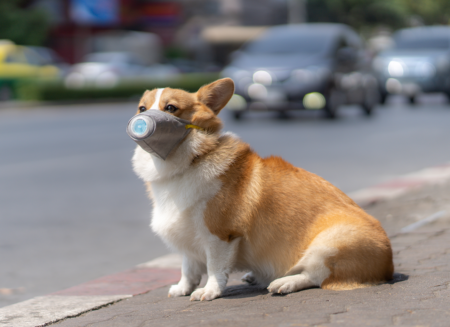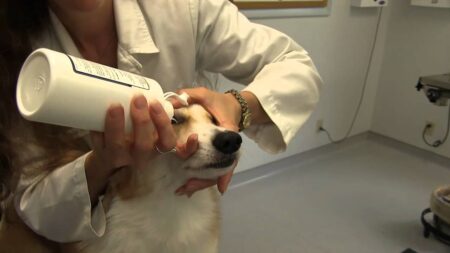Tear gas, also known as riot control agents, is a chemical agent that is used by law enforcement and military agencies for crowd control purposes. It irritates the eyes, skin, and respiratory system, leading to tears, coughing, and difficulty breathing in humans. However, when it comes to whether dogs are immune to tear gas, it is important to understand their physiological differences and how they may react to exposure.
While dogs have different respiratory systems and may have a higher tolerance for certain irritants compared to humans, it is incorrect to say that they are completely immune to tear gas. Dogs can experience discomfort, irritation, and respiratory distress when exposed to tear gas, similar to humans.
The extent of the effects on dogs will depend on various factors such as the breed, age, overall health, and duration of exposure. Additionally, just like humans, individual dogs may react differently to tear gas exposure. Some dogs may exhibit severe symptoms, while others may show only mild signs of discomfort.
Are Dogs Immune to Tear Gas?
Dogs are not immune to tear gas. While dogs may have a higher tolerance for certain irritants compared to humans, tear gas can still cause discomfort and harm to them.
Tear gas, also known as riot control agents, is a chemical compound that irritates the eyes, skin, and respiratory system. When exposed to tear gas, dogs can experience symptoms such as eye irritation, excessive tearing, coughing, difficulty breathing, and general distress.
What is Tear Gas?
Tear gas, also referred to as riot control agents, is a type of chemical compound that is commonly used for crowd control and in certain law enforcement situations. It is designed to cause irritation and temporary incapacitation in individuals exposed to it.
There are several types of chemicals used in tear gas, with the most common being chloroacetophenone (CN) and chlorobenzylidenemalononitrile (CS). These compounds are typically dispersed as fine particles or aerosols through canisters or grenades.
When tear gas is released, it affects the eyes, respiratory system, and skin. It induces tearing, intense burning pain in the eyes, coughing, difficulty breathing, and skin irritation. The purpose of tear gas is to disperse crowds and encourage individuals to leave an area due to the unbearable sensations it causes.
What is Tear gas made of
Tear gas is typically made up of one or more chemical compounds that are designed to irritate the eyes, skin, and respiratory system. The most commonly used compounds in tear gas are chloroacetophenone (CN) and chlorobenzylidenemalononitrile (CS). These compounds are known as riot control agents and are often used by law enforcement and military agencies for crowd control purposes.
Chloroacetophenone (CN) is a white crystalline powder that can be dispersed as a fine aerosol or in the form of grenades. It is primarily an irritant to the eyes, causing intense tearing, burning pain, and temporary vision impairment.
Chlorobenzylidenemalononitrile (CS), also known as CS gas, is a synthetic compound that is usually dispersed in the form of small particles or aerosols. Similar to CN, CS gas irritates the eyes, resulting in tearing and pain. It can also irritate the respiratory system and cause coughing and difficulty breathing.
Other chemical compounds, such as dibenzoxazepine (CR), have been used in the past but are less commonly employed today.
SEE ALSO: Why Do Dogs Sleep With Their Bum Facing You?
How Long Are Dogs Immune to Tear Gas?
Exposure to tear gas can cause serious irritation and discomfort for both humans and animals. For dogs, the effects of tear gas can last anywhere from 15 minutes to several hours, depending on the severity of the exposure. Symptoms can include excessive tearing, redness, and swelling of the eyes, coughing, difficulty breathing, and skin irritation.
How to Tell If Your Dog Is Reacting To Tear Gas?
Here are some signs that may indicate your dog is reacting to tear gas:
- Excessive tearing: Your dog may have increased tearing or watery discharge from their eyes.
- Coughing or choking: If your dog starts coughing or appears to be choking or gasping for air, it could be a sign of respiratory irritation from tear gas.
- Difficulty breathing: Your dog may exhibit labored or rapid breathing or show signs of struggling to catch their breath.
- Pawing at face or eyes: If your dog is experiencing eye irritation from tear gas, they may paw at their face or rub their eyes.
- Excessive salivation or drooling: Tear gas can cause excessive salivation in dogs. You may notice them drooling more than usual.
- Discomfort or restlessness: Your dog may display signs of general discomfort, restlessness, or agitation after exposure to tear gas.
Why Are Dogs Affected by Tear Gas?
Here are a few reasons why dogs are affected by tear gas:
- Similar eye structure: Dogs have similar eye structures to humans, with corneas, pupils, and tear ducts. Tear gas particles can irritate their eyes, leading to tearing, burning sensations, and temporary vision impairment.
- Respiratory system: Dogs have respiratory systems that are sensitive to airborne irritants. When exposed to tear gas, dogs can experience coughing, difficulty breathing, and respiratory distress.
- Skin sensitivity: Tear gas can also cause skin irritation in dogs, as their skin is sensitive to chemical irritants. It can lead to redness, itching, and discomfort.
- Smaller size: Dogs come in different sizes, and smaller breeds may be more sensitive to tear gas due to their smaller lung capacity and overall size. This can make them more susceptible to the effects of the chemical compounds.
How to Protect Your Dog from Tear Gas
If you find yourself in a situation where tear gas is being used or there is a risk of exposure, it’s important to take steps to protect your dog. Here are some measures you can consider:
- Remove your dog from the area: If tear gas is being deployed or there is a potential for its use, immediately move your dog away from the affected area to a safe location. This may include going indoors or moving to an open and well-ventilated space away from the source.
- Use a leash and harness: Ensure that your dog is wearing a secure leash and harness to keep them under control and prevent them from running off or getting lost in a panic.
- Protect their eyes: If tear gas is being used, consider using protective eyewear for your dog. Dog goggles or even clear plastic goggles can help shield their eyes from the irritants.
- Cover their nose and mouth: If possible, you can try using a cloth or bandana to cover your dog’s nose and mouth to reduce their exposure to airborne particles. Make sure it is breathable and not overly restrictive for them.
- Rinse their eyes and paws: If your dog does come into contact with tear gas, gently flush their eyes with clean water or a saline solution to help alleviate any irritation. It’s also a good idea to rinse their paws and fur to remove any potential residue.
- Seek veterinary attention: If your dog shows signs of distress or discomfort after tear gas exposure, it is important to consult with a veterinarian promptly. They can assess your dog’s condition and provide appropriate treatment or advice.
How to Treat a Dog That Has Been Exposed to Tear Gas
Here are some steps you can take to help your dog before reaching the vet:
- Move your dog to fresh air: Quickly remove your dog from the area where tear gas was released and take them to a well-ventilated space or outdoors where they can breathe clean air. Avoid exposing your dog to any remaining tear gas residue.
- Rinse your dog’s eyes and face: Gently flush your dog’s eyes and face with lukewarm water or a sterile saline solution. This will help to remove any tear gas residue and reduce irritation. Avoid using any cleaning products or chemicals on your dog’s face or eyes unless instructed by a veterinarian.
- Check for other symptoms: Keep an eye out for signs of respiratory distress, coughing, wheezing, or difficulty breathing. If your dog is displaying any of these symptoms, seek immediate veterinary care.
- Do not induce vomiting: If your dog has ingested tear gas, do not induce vomiting unless specifically directed by a veterinarian. Some tear gas products can cause further damage when regurgitated.
- Keep your dog calm and comfortable: Comfort your dog and keep them calm during this stressful time. Avoid any stressful activities or situations that could worsen their condition.
SEE ALSO: Symptoms of Dead Kitten Inside Cat
FAQs
Q. Are dogs immune to tear gas or pepper spray?
A. While dogs are not completely immune to the effects of tear gas or pepper spray, they are more resistant to the effects than humans.
Q. Does tear gas affect horses?
A. Yes, tear gas can hurt horses. Like humans and other animals, horses can experience irritation of the eyes, nose, and throat when exposed to tear gas. In addition, horses can develop respiratory problems, including difficulty breathing and pneumonia.
Q. Does OC affect dogs?
A. Yes, OC (oleoresin capsicum) can affect dogs. OC is the active ingredient in pepper spray, and it’s also found in some other products, like dog repellents. When a dog comes into contact with OC, it can irritate the eyes, nose, and throat.
Conclusion
In conclusion, while dogs may have a higher tolerance to tear gas compared to humans, they are not immune to its effects. Tear gas can still cause significant discomfort, irritation, and potential harm to a dog’s eyes, nose, throat, and respiratory system. It is important to prioritize the safety and well-being of your dog by avoiding areas where tear gas is present and seeking veterinary care if your dog has been exposed.
